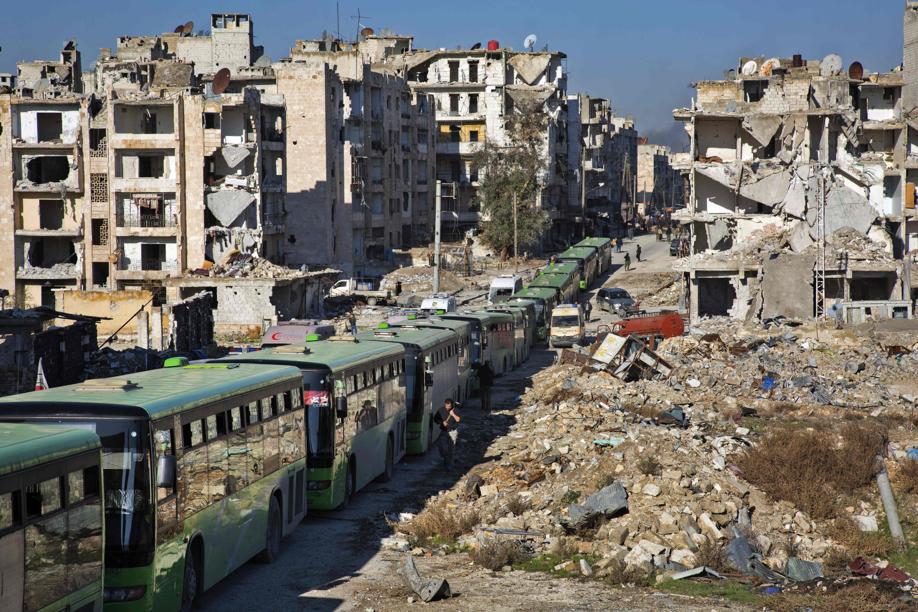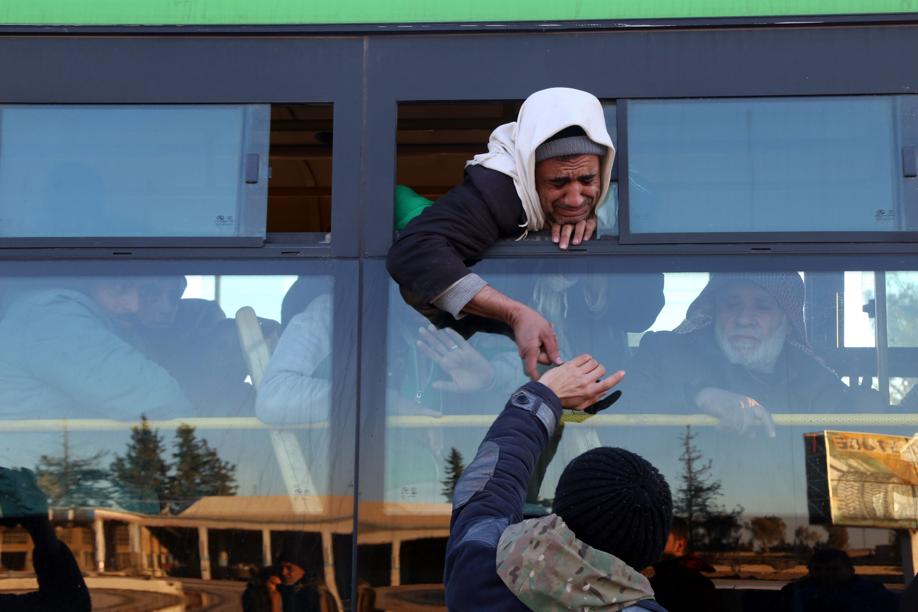

BEIRUT — Around 1,000 people were evacuated from the remaining rebel-held districts of the Syrian city of Aleppo on Thursday, part of a process that could become one of the greatest victories of the war for President Bashar Assad and a major blow to his foes.
After new violence in Syria’s second-largest city stopped the evacuation Wednesday and delayed it Thursday morning, long lines of government buses and ambulances crossed into the rebel-held enclave and returned with about 1,000 evacuees, according to Russia, which helped carry out the agreement, and the World Health Organization, which monitored it.
Assad hailed the evacuation in a video released by his office, comparing it to historical events like the birth of Christ, the revelation of the Koran, the collapse of the Soviet Union, and the two world wars.
“I want to confirm that what is happening today is history that is being written by every Syrian civilian,’’ Assad said, smiling in a dark blue suit. “Its writing did not start today. It started about six years ago when the crisis and the war on Syria began.’’
If successful, the evacuation deal will signal a major turning point in Syria’s nearly six-year conflict. Since early in the war, Aleppo, once the country’s industrial center, has been split, with the government holding the west and rebels holding many neighborhoods in the east.
But military aid for the Syrian government from Iran, Russia, and the Lebanese militant group Hezbollah turned the tide in the government’s favor, allowing it to surround the rebels.
The loss of any foothold in Aleppo would be a major blow to the opposition, which would then hold sway in only one of Syria’s provincial capitals, Idlib, where the Syrian branch of Al Qaeda is a major force.
The evacuation deal was reached between Russia, which backs the Syrian government, and Turkey, which backs the rebels, after months of airstrikes and heavy shelling that left entire neighborhoods in ruins and killed hundreds of people.
Rebels in the east also shelled government-held areas, killing civilians there, too.
The evacuation began Wednesday morning, but soon collapsed when militia fighters allied with the Syrian government and unhappy with the deal opened fire on vehicles bringing people out, according to opposition activists.
The Syrian Observatory for Human Rights, which opposes the government and tracks the conflict from Britain, said the presence of 250 foreign fighters among those to be evacuated also complicated the deal because the Syrian government wanted to detain them for interrogation.
It remained unclear how that issue was resolved.
Evacuation efforts restarted Thursday morning, with apparent modifications to the plan. Syrian state news media reported that buses and ambulances had begun evacuating residents from two Shi’ite villages in neighboring Idlib province that have long been surrounded by Sunni rebels. The two villages, Fua and Kfraya, were not originally part of the evacuation deal. The moves to evacuate people from the villages suggested that they had been added to the deal to ensure that people in eastern Aleppo would be allowed to leave.
Then, new gunfire inside Aleppo hindered the start of the evacuation there. Maan al-Shanan, an antigovernment activist in the east of the city, said pro-government forces had opened fire on rescue workers who were clearing rubble from the road to allow buses and ambulances to pass, killing one person and wounding three others.
The White Helmets, a group of volunteer emergency workers, said on Twitter that one of its members had been struck by a bullet fired by a government sniper.
But the evacuation continued, and by midday, Syrian state television was showing live footage of buses and ambulances returning to the government-held side of the city.
It remained unclear how many people, both civilians and fighters, remained in eastern Aleppo and how long it would take to evacuate all those who wanted to leave. When the area was besieged by government forces and their allies, the United Nations reported that more than 250,000 people were stuck inside.
Speaking to journalists in Geneva, Jan Egeland, the UN humanitarian adviser for Syria, said an estimated 50,000 people had fled eastern Aleppo.
The plight of those trapped in eastern Aleppo as supplies have dwindled and destruction has spread has caused anguish among humanitarian workers.



